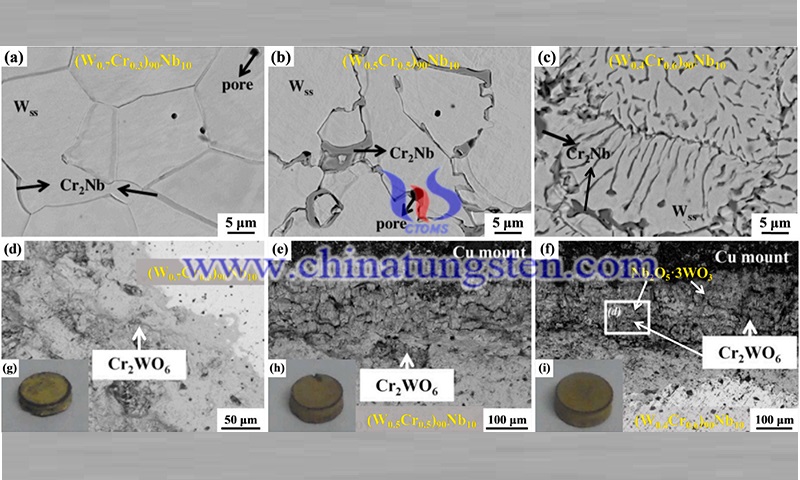Oxidation Behavior of W-Cr-Y Ternary Alloys
- Details
- Category: Tungsten's News
- Published on Saturday, 22 April 2023 15:48
Calvo et al. prepared W-Cr-Y ternary alloys with Cr content of 8 and 10 wt% and Y content of 0.3, 0.5 and 1 wt% by HIP technique and studied their oxidation behavior. The microstructure pictures of the HIPed alloy surface showed a fine surface structure and homogeneous composition. EDS analysis showed that most of the bright gray areas were Cr-rich phases, while the dark gray discontinuous areas were W-rich phase. The W-Cr-Y alloy has a lower grain size of 0.5-1 µm compared to the W-15Cr alloy. This suggests that the addition of Y can act as a grain growth inhibitor. In addition, nanoscale black Y2O3 particles were observed at the grain boundaries, which were caused by the decomposition of unstable oxides during the HIPing process.

In addition, Y-O-rich nanoparticles were observed on the surface of the alloy with a Y content of 1 wt%. Due to the relatively high Y content in the alloy, part of the Y was not oxidized and enriched on the surface of the alloy. The cross section of the oxidized alloy consists of a thin Cr2O3 layer, a Cr2WO6 layer, and a WO3 layer. A large number of pores were observed at the interface between the WO3 and Cr2WO6 layers, which were mainly due to the compressive stresses generated during the oxidation process and the volume expansion of the oxides. In addition, a large number of cracks and pores were also observed on the surface of the oxidized W-8Cr-0.5Y alloy. Therefore, it is difficult to form a continuous dense protective film on the surface of the alloy when the Cr content is low. Y2W3O12 particles were observed on the surfaces of the other two oxidized alloys.
The particle distribution on the surface of the W-Cr-Y ternary alloy is relatively dispersed. When the Y content was 1 wt%, the coating surface was almost completely covered by the Cr2O3 layer, and only a small amount of Y2W3O12 phase was observed. the highest oxidation rate was observed for W-10Cr-0.3Y alloy, W-10Cr-0.5Y and W-8Cr-0.5Y alloys showed similar oxidation behavior, while the lowest oxidation rate was observed for W-10Cr-1Y alloy. Therefore, Y2W3O12 particles can promote the formation of Cr2O3 protective film and Y elements can significantly improve the oxidation resistance of W-Cr alloys.

Reference: Fu T, Cui K, Zhang Y, et al. Oxidation protection of tungsten alloys for nuclear fusion applications: A comprehensive review[J]. Journal of Alloys and Compounds, 2021, 884: 161057.
- Tungsten Manufacturer & Supplier, Chinatungsten Online: www.chinatungsten.com
- Tungsten News & Prices of China Tungsten Industry Association: www.ctia.com.cn
- Molybdenum News & Price: news.molybdenum.com.cn
- Tel.: 86 592 5129696; Fax: 86 592 5129797; Email: sales@chinatungsten.com



 sales@chinatungsten.com
sales@chinatungsten.com